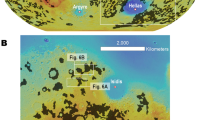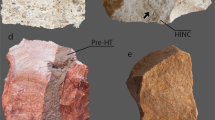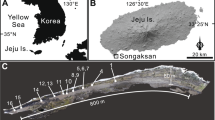Abstract
RECENTLY, Stephens1 has suggested that the widespread silcretes of Central Australia can be explained by a sequence of three events: (1) mobilization of silica by lateritic weathering in the area of the present watershed of eastern and northern Queensland; (2) deposition of the silica after south-western transportation in streams and rivers for considerable distance (up to 900 miles) on a wide, gently sloping surface underlain by a large array of rocks; (3) erosive break-up of the silcrete sheet so formed due to rejuvenation, to leave caps on mesas and extensive stony pavements.
This is a preview of subscription content, access via your institution
Access options
Subscribe to this journal
Receive 51 print issues and online access
$199.00 per year
only $3.90 per issue
Buy this article
- Purchase on Springer Link
- Instant access to full article PDF
Prices may be subject to local taxes which are calculated during checkout
Similar content being viewed by others
References
Stephens, C. G., Nature, 203, 1407 (1964).
King, L. C., The Morphology of the Earth, 171 (Oliver and Boyd, 1962).
Brückner, W. D., Geol. Rundschau, 43, 307 (1955).
Brückner, W. D., Eclogae Geol. Helv., 50, 239 (1957).
Author information
Authors and Affiliations
Rights and permissions
About this article
Cite this article
BRÜCKNER, W. Origin of Silcretes of Central Australia. Nature 209, 496–497 (1966). https://doi.org/10.1038/209496b0
Issue Date:
DOI: https://doi.org/10.1038/209496b0
Comments
By submitting a comment you agree to abide by our Terms and Community Guidelines. If you find something abusive or that does not comply with our terms or guidelines please flag it as inappropriate.



